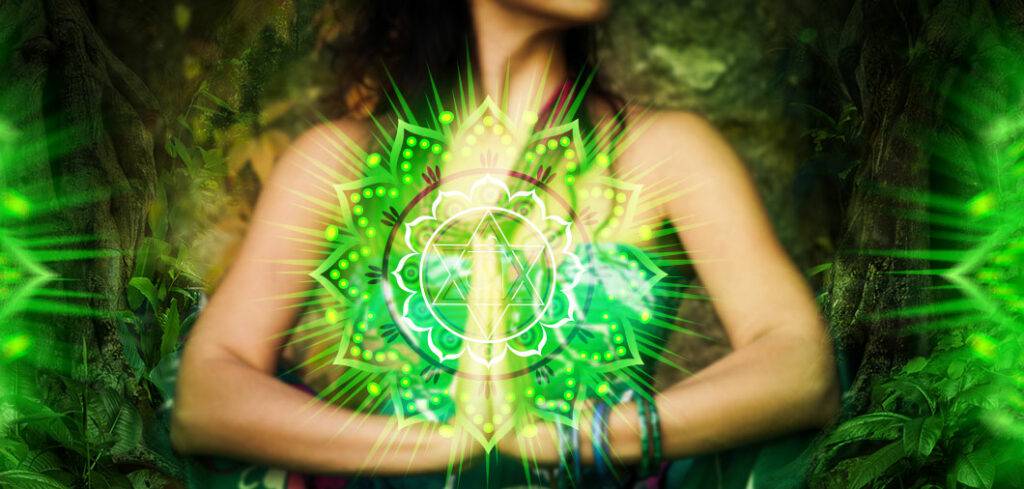The fourth of the 7 chakras in the human body is Heart Chakra, the mysterious energy center that holds the key to love, compassion and emotional balance. In this article, you will discover techniques and wisdom to balance and heal this vital chakra, allowing you to cultivate self-love, enhance empathy, and nurture harmonious relationships with others. This is a chakra that the members of LotusBuddhas truly care about because it helps us, the Buddhist practitioners, to cultivate and develop compassion.
| Attribute | Description |
|---|---|
| Sanskrit Name | Anahata |
| Location | Center of the chest, near the heart |
| Color | Green |
| Element | Air |
| Symbol | 12-petaled lotus |
| Associated Organ/Body Part | Heart, lungs, thymus gland |
| Functions | The Heart Chakra governs our capacity to give and receive love. It also relates to compassion, empathy, forgiveness, and transformation. This chakra bridges the gap between the physical and spiritual realms, making it vital for healing and maintaining mental health and emotional equilibrium. |
| Balanced Characteristics | When the Heart Chakra is balanced, one exhibits love for oneself and others, compassion, empathy, and forgiveness. These individuals often have a deep sense of peace and tranquility and are able to easily relate to others. |
| Imbalanced Characteristics | An imbalanced Heart Chakra can lead to emotional instability, difficulty in relationships, lack of empathy, and an inability to forgive or let go of past hurts. Physically, it can manifest as heart disease, respiratory issues, or upper back and shoulder pain. |
| Healing Practices | Practices that can help balance the Heart Chakra include loving-kindness meditation, practicing forgiveness, yoga poses like the camel pose and the cobra pose, and using crystals like rose quartz or green aventurine. |
| Associated Yoga Poses | Cobra Pose (Bhujangasana), Camel Pose (Ustrasana), and Eagle Pose (Garudasana) |
| Healing Crystals | Rose Quartz, Green Aventurine, Amazonite, Rhodonite |
| Affirmation | “I am love. I forgive myself and others. I give and receive love freely.” |
What is the Heart Chakra?

The Heart Chakra, known as Anahata in Sanskrit, serves as a bridge between our physical and mental bodies, embodying the essence of love, compassion, and connection. Located in the center of your chest, just above the heart, it is the fourth chakra and the center of our chakra system, no pun intended!
Imagine the Heart Chakra as the core of your emotional being, where love, kindness, and compassion flow freely. When this chakra is open and balanced, you experience deep connections and empathy with others, you feel a sense of inner peace and joy, and your love flows freely.
However, difficulties in life can sometimes cause this chakra to become closed or unbalanced. You may feel isolated, have difficulty communicating with others, or become overly defensive. Physical symptoms may include heart problems, asthma, or problems with your lungs and upper back.
To nourish the Heart Chakra, practices such as forgiving, expressing gratitude, and performing acts of kindness can have incredible healing effects. In yoga, chest-opening poses such as cobra pose or camel pose can help stimulate this chakra. Meditation focused on the Heart Chakra, visualizing brilliant blue light (the color associated with this chakra) filling the area, can also promote healing and balance.
Cultivating love, not only for others but also for yourself, is key to a healthy Heart Chakra. By practicing self-compassion, you open your heart to receive and give love more freely, connecting with the world around you in a more meaningful way.
Signs of Overactivity in Heart Chakra
Signs of overactivity in the Heart Chakra may manifest in various ways, reflecting an imbalance in one’s emotional and spiritual life. Some of these indicators include:
Excessive self-sacrifice: An overactive Heart Chakra may lead to a constant need to put others’ needs before one’s own, even to the point of self-neglect or exhaustion. This can stem from a misguided sense of altruism or an inability to establish healthy boundaries.
Overwhelming empathy: While empathy is a positive trait, an overactive Heart Chakra can lead to an overwhelming sense of empathy, causing one to absorb others’ emotions too deeply. This may result in emotional instability, mood swings, and an inability to differentiate between personal and external feelings.
Codependency: An overactive Heart Chakra may foster unhealthy codependent relationships, wherein one’s sense of self-worth and identity becomes reliant on the approval and validation of others. This can lead to a loss of autonomy and an unhealthy attachment to people.
Possessiveness: Excessive love and attachment may turn into possessiveness, jealousy and controlling behavior, all signs of an overactive Heart Chakra. This can result in strained relationships and an inability to trust or let go.
Difficulty setting boundaries: An overactive Heart Chakra may lead to a constant desire to please others and an inability to say “no.” This can result in feelings of resentment, as one may feel taken advantage of or unappreciated.
Signs of a Blocked Heart Chakra
The Heart Chakra, or Anahata in Sanskrit, is like the bridge connecting the lower chakras (associated with materiality) and the upper chakras (associated with spirituality). When your Heart Chakra is blocked or out of balance, you might feel it on several levels: emotionally, physically, and in your relationships. Here’s what to look out for:
- Emotional Signs: You might experience overwhelming feelings of jealousy, anger, bitterness, or a sense of being unloved. Difficulty in forgiving or an inability to let go of past hurts are also common symptoms. You might feel closed down, withdrawn, or find it hard to connect with others.
- Physical Symptoms: The Heart Chakra is associated with the heart, lungs, and circulatory system. So, if it’s blocked, you might encounter issues like respiratory problems, high blood pressure, or heart-related conditions. There might also be a general feeling of discomfort in the chest area.
- Relational Impact: With a blocked Heart Chakra, relationships can feel strained. You might find yourself either clinging too tightly to loved ones or pushing them away. There’s often a fear of intimacy or a pattern of sabotaging relationships, perhaps because of trust issues or fear of rejection.
- Lack of Empathy: If the Heart Chakra is blocked, understanding others’ feelings or viewpoints can be challenging. There might be a lack of compassion or an inability to see beyond one’s own needs and experiences.
- Overcompensation: Sometimes, when the Heart Chakra is blocked, there can be an overcompensation in trying to prove one’s love or worthiness. This might manifest as people-pleasing behavior, where one constantly seeks approval or validation from others.
Recognizing these signs is the first step toward healing. Once you’re aware of a blockage, you can take proactive steps through practices like meditation, yoga, and self-care activities focused on opening and balancing the Heart Chakra. Cultivating self-love and compassion for others also plays a crucial role in this healing process.
Benefits of a Balanced Heart Chakra
A balanced heart chakra is necessary to live a harmonious and fulfilling life. Indeed! We have found that when in a state of balance, this chakra releases countless benefits that enhance the relationships, inner peace, and overall vitality of the members of LotusBuddhas.
1. Enhanced emotional intelligence
A balanced heart chakra promotes emotional intelligence by fostering self-awareness and understanding of others’ emotions. This heightened sensitivity enables us to navigate complex social situations with grace and empathy, enhancing our personal and professional relationships.
2. Deepened connections and relationships
With a balanced heart chakra, we are more open to giving and receiving love, allowing us to forge deeper connections with friends, family, and romantic partners. We become more attuned to the needs of others and are better equipped to provide support and compassion when needed, nurturing relationships that are built on trust and mutual respect.
3. Cultivation of self-love and acceptance
A harmonious heart chakra encourages us to embrace self-love and acceptance, recognizing our intrinsic worth and value. This self-compassion empowers us to set healthy boundaries, pursue personal growth, and prioritize self-care, contributing to our overall well-being and happiness.
4. Increased empathy and compassion
A balanced heart chakra enables us to feel greater empathy and compassion for others, fostering a sense of interconnectedness and understanding. This increased sensitivity to the experiences of those around us encourages us to act with kindness and consideration, promoting a more compassionate and harmonious world.
5. Inner peace and emotional stability
When our heart chakra is in balance, we experience a profound sense of inner peace and emotional stability. Our emotions become more manageable, and we are better equipped to handle stress, conflict, and challenging situations with grace and resilience.
6. Enhanced creativity and inspiration
A balanced heart chakra can serve as a conduit for creativity and inspiration, allowing us to express ourselves authentically through various forms of art, writing, or music. As we tap into our emotions and experiences, we can channel this energy into powerful creative expressions that resonate with others and enrich our lives.
7. Physical health benefits
The heart chakra’s energetic influence extends to our physical well-being, affecting our cardiovascular and respiratory systems. When in balance, the heart chakra can promote optimal heart health, support healthy blood circulation, and encourage deep, nourishing breaths that contribute to overall vitality.
8. Spiritual growth and connection
A harmonious heart chakra paves the way for spiritual growth and connection. As we cultivate love, compassion, and forgiveness, we open ourselves to the possibility of a deeper connection with our higher selves, the universe, and a greater sense of purpose in our lives.
How to Open and Balance Heart Chakra
Opening and balancing the Heart Chakra is a beautiful journey of nurturing love, compassion, and acceptance. Here are some heartfelt ways to foster harmony in your Anahata Chakra:
- Practice Loving-Kindness Meditation (Metta): This meditation focuses on cultivating love and kindness towards yourself and others. By sending well wishes to people in your life, including those you find challenging, you can open and balance your Heart Chakra.
- Engage in Heart-Opening Yoga Poses: Poses like Camel Pose (Ustrasana), Cobra Pose (Bhujangasana), and Bridge Pose (Setu Bandhasana) can help open the chest area, encouraging the flow of energy through the Heart Chakra. These poses also help release any emotional blockages tied to the heart.
- Use Green and Pink Crystals: Stones like rose quartz and green aventurine resonate with the Heart Chakra’s energy. Carrying these crystals with you or placing them over your heart during meditation can enhance the chakra’s healing.
- Practice Forgiveness: Holding onto past hurts can block your Heart Chakra. Forgiveness, whether it’s forgiving yourself or others, can release these blockages, fostering inner peace and opening the heart.
- Connect with Nature: Spending time in green spaces can help attune your Heart Chakra to the frequency of the Earth, promoting healing and balance. Try walking barefoot to ground yourself and enhance this connection.
- Adopt Heart-Centered Breathing: Visualize breathing in and out through your heart. This practice can help you center yourself in the energy of love and compassion, balancing the Heart Chakra.
- Express Gratitude: Regularly acknowledging the things you are thankful for can open your heart to receive and give love. You might keep a gratitude journal or simply take a few moments each day to reflect on what you’re grateful for.
- Surround Yourself with Love: Engage in activities that you love and spend time with people who uplift you. Being in a state of joy and love naturally resonates with and balances the Heart Chakra.
Remember, the journey to balance your Heart Chakra is a process of opening yourself up to love and compassion. Be patient and gentle with yourself, allowing your heart to open in its own time and way.
Best Crystals for Healing the Heart Chakra
Healing the Heart Chakra can be a profoundly nurturing process, and incorporating crystals into your practice can add a layer of intention and energy to your healing journey. The Heart Chakra resonates with the color green, reflecting growth, renewal, and the healing essence of nature. Pink stones also resonate well, symbolizing love and compassion. Here are some of the best crystals to support the Heart Chakra:
- Rose Quartz: Often referred to as the stone of unconditional love, rose quartz is a cornerstone for healing the Heart Chakra. It promotes compassion, forgiveness, and self-love, helping to dissolve emotional wounds and fears.
- Green Aventurine: Known as the stone of opportunity, Green Aventurine is believed to bring luck and prosperity. But it’s also powerful for Heart Chakra work, encouraging emotional calm, a sense of well-being, and emotional recovery.
- Rhodonite: This stone is like a first aid kit for emotional healing, particularly beneficial for processing and releasing past hurts. It fosters forgiveness and helps in mending a broken heart.
- Emerald: A stone of successful love, Emerald supports loyalty, unity, and partnership, promoting friendship and balance between partners. It’s also said to provide healing and vitality to the Heart Chakra.
- Jade: Associated with the heart’s health and harmony, Jade balances and harmonizes the Heart Chakra, aiding in both emotional and physical well-being. It’s known for attracting love and nurturing energy.
- Malachite: A stone of transformation, Malachite is powerful for clearing and activating the Heart Chakra. It absorbs negative energies and pollutants from the atmosphere and the body, promoting healing and positive change.
- Pink Tourmaline: This crystal helps heal the heart from emotional wounds and infuses your aura with the energy of love and kindness. It’s particularly supportive in helping to heal from the loss of love.
When working with these crystals, you can carry them in your pocket, wear them as jewelry, place them on your heart during meditation, or even sleep with them under your pillow. The intention is key—focus on your desire for heart healing and balance as you work with these stones. Over time, you may begin to notice a gentle softening and opening of your Heart Chakra, cultivating an environment where love can flourish.
Yoga Poses to Stimulate the Heart Chakra
The Heart Chakra is the center of love, compassion, and forgiveness. Nourishing this chakra through yoga can help open your heart to receiving and expressing these essential qualities. Here are some of the most effective yoga poses to stimulate the Heart Chakra:
- Cobra Pose (Bhujangasana): This backbend opens the chest and encourages deep breathing, which can energize the Heart Chakra. Lying on your stomach, place your hands under your shoulders and push your upper body off the floor while keeping your lower body grounded.
- Camel Pose (Ustrasana): This pose stretches the entire front body and encourages openness and vulnerability. Kneel on your mat with your knees hip-distance apart, lean back and try to reach your ankles. If this is too much, you can place your hands on your lower back for support.
- Eagle Pose (Garudasana): This pose requires balance and focus and can help to release tension in the heart center. From a standing position, cross one leg over the other and one arm under the other, then try to bring your palms together.
- Fish Pose (Matsyasana): This pose expands the chest and throat and can help to release blockages in the Heart Chakra. Lying on your back, lift your chest and lower your head backward towards the mat, while your lower body remains flat on the ground.
- Upward-Facing Dog (Urdhva Mukha Svanasana): This pose strengthens the upper body and opens the chest, stimulating the Heart Chakra. From a prone position, press your palms into the mat just below your shoulders, straighten your arms, and lift your torso and legs a few inches off the mat.
- Bow Pose (Dhanurasana): By opening the chest and stretching the whole body, this pose helps stimulate the Heart Chakra. Lying on your stomach, bend your knees and reach back to grab your ankles, then pull with your hands to lift your thighs off the mat.
- Wheel Pose (Urdhva Dhanurasana): This advanced pose is a powerful heart opener that can energize the whole body and stimulate the Heart Chakra. Lying on your back, bend your knees and place your feet on the ground. Place your hands next to your head with fingers pointing towards your shoulders, press into your palms and lift your whole body off the ground.
As with any yoga practice, you must to approach these poses with care and to stay within your comfort zone to avoid injury. Use these poses as a tool to open your Heart Chakra, embracing the feelings of love and compassion that arise.
Through this article, LotusBuddhas hopes that you can gain a deeper understanding of the heart chakra, its meaning, role, and how to balance it to develop positive qualities within yourself. Additionally, LotusBuddhas recommends that you learn more about the other chakras such as the Root Chakra, Sacral Chakra, Solar Plexus Chakra, Throat Chakra, Third Eye Chakra, and Crown Chakra to have a more comprehensive understanding of the energy system running through the human body.











